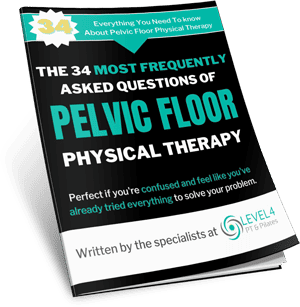
Are you worried you have a Pelvic Organ Prolapse?
Some women consider living with pelvic organ prolapse like carrying a bowling ball around in their underwear. It sounds dramatic – if you haven’t experienced it. Still, this description perfectly illustrates the unrelenting pressure and tugging pain inside the vagina that accompanies this common women’s health complaint. But actually, women tell us it’s the psychological weight of the condition that weighs heaviest.
Sex hurts.
You likely have low back pain.
You need to pee ALL the time.
It’s miserable.
But perhaps the worse feeling of all, when you’re dealing with a Pelvic Organ Prolapse, is the sensation that your insides are going to spill out onto the sidewalk. Which makes you not want to walk, work, exercise, or socialize.
You want to stay home and hide, right?
If you are one of the unlucky ones who have severe symptoms, it may surprise you to learn that some women find out by surprise during their annual Pap Smear. When their doctor tells them that they have a prolapse – because they don’t experience any symptoms. Or, worse still, the first thing they know about it is when they see or feel a lump or bulge in or protruding from their vagina or anus.
But even without symptoms, “prolapse” is not the news any woman wants to hear. It can be pretty horrifying if you haven’t experienced it before. But it doesn’t have to be scary. It’s not a life sentence either. It’s fixable – with the proper support.
You can get your life back.
What is Pelvic Organ Prolapse?

The term Pelvic Organ Prolapse refers to one or more of your pelvic organs, such as the uterus, bowel, or bladder, sliding down and bulging into or outside of your vaginal canal or anus.
But Pelvic Organ Prolapse is a bit of a catch-all name because this condition can present itself in so many different ways. It’s not one thing.
Every woman is different.
For instance, the most common version of Pelvic Organ Prolapse is when the bladder prolapses into the vagina. We call this a cystocele. But this is most definitely not the only type of prolapse. You may also suffer from:
Vaginal Vault Prolapse – is where the upper section of the vagina falls into the vaginal canal or protrudes out of the vagina. It is common after full or partial hysterectomy.
Uterine Prolapse – is where the womb moves down from its usual position and encroaches into the vaginal canal. In severe cases, your uterine tissue may protrude outside the vagina. This type of prolapse is most commonly due to the pressure of pregnancy, excess weight, or repetitive coughing.
Urethrocele – is where the urethra, the tube that transports urine out of the body, protrudes into the vaginal canal. This condition is most commonly associated with childbirth as the baby moves through the birth canal. It usually occurs in tandem with a cystocele: a bladder prolapse, but it can happen independently.
Enterocele – is where the small bowel descends into the lower pelvis area and puts pressure on the top of the vagina, creating a lump inside or outside of the vagina. Like all prolapses, an enterocele occurs when the pelvic floor muscles lose strength. But they can be brought on by constipation, straining, and coughing.
Rectocele – is where the rectum bulges forward into the vaginal wall.
Without professional consultation, it’s hard to know which of these specific types of prolapse you’re suffering from. They all cause similar symptoms like pelvic pain and pressure and problems urinating or moving your bowels. Effective treatment for all types of Pelvic Organ Prolapse starts with proper diagnosis – as treatment protocols differ for each one.
Sadly, Pelvic Organ Prolapse sometimes slips under the radar. It can go undiagnosed and untreated because it’s often confused with other conditions. These include urinary stress incontinence and overactive bladder. The prolapse causes similarly increased urination, leakage, and a failure to empty the bladder properly.
Do you have Pelvic Organ Prolapse? What type do you have?
Talk to a Physical Therapist now.
To properly diagnose a Pelvic Organ Prolapse, rule out other health conditions, and find the root cause of your symptoms, we may also recommend an X-ray of the urinary tract, a pelvic ultrasound, an MRI, or a CT scan of the pelvis. Although this may not be necessary as lots of women discover their prolapse at their annual PAP Smear, so it’s already been confirmed by a Medical Doctor. This diagnosis is one of the benefits of having a yearly check-up. We can then get straight to work on fixing the problem and improving your symptoms.
What Causes Pelvic Organ Prolapse?

Pelvic Organ Prolapse is most likely to occur when the pelvic floor muscles have become weakened. They’re no longer able to hold the pelvic organs in place effectively.
Some genetic conditions and inherited connective tissue disorders can cause this muscle weakness, such as Benign Hypermobility Syndrome, Ehlers-Danos Syndrome (EDS), or Marfan Syndrome. But these conditions are rare.
In most cases, pelvic floor weakness results from wear and tear, hysterectomy, or vaginal childbirth, particularly in long labors, difficult births, and large babies. It may also stem from excess weight, repetitive strain, heavy lifting, bowel resection, gynecological cancers, other abdominal surgeries, or even chronic constipation. In other words, anything that puts prolonged pressure on the abdomen and pelvic organs.
How To Fix Pelvic Organ Prolapse

Well, the first thing we should say is that Pelvic Organ Prolapses tend to worsen over time. It won’t go away or fix itself, so we recommend you not delay getting treatment to give yourself the best chance of full resolution.
Depending on the severity of the prolapse and its effect on your daily life, your MD may recommend corrective surgery. There are various surgical options to lift and repair major pelvic organ prolapses, including vaginal mesh surgery, a complete hysterectomy – or in the most severe cases closing the vagina.
All of these options should be a last resort. They require lots of downtime. You’ll need up to 12 weeks off work and need to refrain from sex and using tampons and other sanitary protection in that time too. As with all surgeries, there is a risk of serious complications too. But your doctor will help you decide whether the surgical route is right for you. The benefits may outweigh the risks if your prolapse is severe enough to warrant it.
But suppose your Pelvic Organ Prolapse is milder to moderate. In that case, non-surgical treatment may be the best and least invasive option. These include lifestyle changes, losing weight, and treating chronic constipation with a high fiber diet, if necessary.

*Remember, anything that puts strain on your pelvic organs can exacerbate Pelvic Organ Prolapse symptoms.
After menopause, some women find that supplementary Estrogen – as a pill, patch, pessary, or cream – can ease some of the things that can make Pelvic Organ Prolapse worse. These include vaginal dryness and the associated painful intercourse. But hormone replacement therapy is not for everyone. As with surgery, you need to weigh up the pros and cons.
You could also consider using latex vaginal pessaries inserted into the vagina to bolster your pelvic floor muscles and provide extra support for your pelvic organs and prevent damage to the vaginal wall.
The most common type of vaginal pessary for Pelvic Organ Prolapse is called a Ring Pessary, which you can insert and remove yourself. You can also still have sex while wearing a Ring Pessary – although lots of women prefer to remove and reinsert.
This non-surgical device, and others like it, are a good option when you need additional support but would like to have more children. In this case, you want to avoid radical surgery or hysterectomy.
Vaginal pessaries are safe and non-invasive, but they’re not without risks from infection, allergic reactions, or irritation. Talk to your doctor about the best option for you. If you’ve ever had an allergy to latex, they may not be suitable for you.
Physical Therapy and specific pelvic floor exercises have also proven to be highly beneficial for mild to moderate Pelvic Organ Prolapses. At Level 4 PT & Wellness, we specialize in helping women be the best version of themselves by treating all pelvic pain and dysfunction forms – from Urinary Stress Incontinence, Diastasis Recti, and Post-natal Back Pain to painful sex and pelvic organ prolapses.
We offer all new patients a free call with one of our Women’s Health Specialists to determine whether we’re the right fit for you. During the call, we answer your questions about Pelvic Organ Prolapse and explain how we can help. Book your call now.
Alternatively, visit us at the clinic for a complimentary 30-minute Discovery Session and meet your Physical Therapist in person.
If we can help you, then we will do exactly that. Reach out to us at any time through our contact page. We look forward to helping you out and getting your life back.
- 3 Proven Ways You Can Relieve Sciatic Pain While Sleeping - September 14, 2023
- Menopause and the Impact It Can Have On Your Weight - August 4, 2023
- 5 Ways That Pilates Can Help With Back Pain - July 19, 2023


















